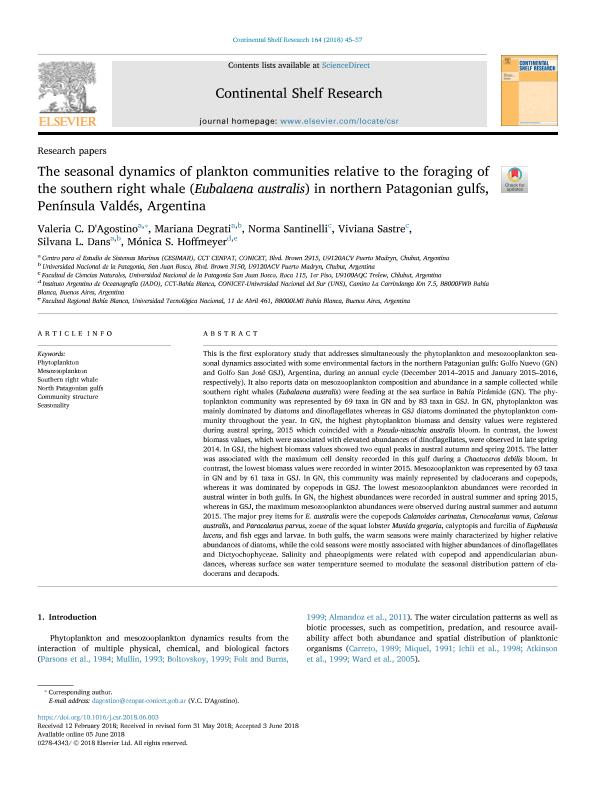Artículo
The seasonal dynamics of plankton communities relative to the foraging of the southern right whale (Eubalaena australis) in northern Patagonian gulfs, Península Valdés, Argentina
D'agostino, Valeria Carina ; Degrati, Mariana
; Degrati, Mariana ; Santinelli, Norma Herminia; Sastre, Alicia Viviana; Dans, Silvana Laura
; Santinelli, Norma Herminia; Sastre, Alicia Viviana; Dans, Silvana Laura ; Hoffmeyer, Monica Susana
; Hoffmeyer, Monica Susana
 ; Degrati, Mariana
; Degrati, Mariana ; Santinelli, Norma Herminia; Sastre, Alicia Viviana; Dans, Silvana Laura
; Santinelli, Norma Herminia; Sastre, Alicia Viviana; Dans, Silvana Laura ; Hoffmeyer, Monica Susana
; Hoffmeyer, Monica Susana
Fecha de publicación:
07/2018
Editorial:
Pergamon-Elsevier Science Ltd
Revista:
Continental Shelf Research
ISSN:
0278-4343
Idioma:
Inglés
Tipo de recurso:
Artículo publicado
Clasificación temática:
Resumen
This is the first exploratory study that addresses simultaneously the phytoplankton and mesozooplankton seasonal dynamics associated with some environmental factors in the northern Patagonian gulfs: Golfo Nuevo (GN) and Golfo San José GSJ), Argentina, during an annual cycle (December 2014–2015 and January 2015–2016, respectively). It also reports data on mesozooplankton composition and abundance in a sample collected while southern right whales (Eubalaena australis) were feeding at the sea surface in Bahía Pirámide (GN). The phytoplankton community was represented by 69 taxa in GN and by 83 taxa in GSJ. In GN, phytoplankton was mainly dominated by diatoms and dinoflagellates whereas in GSJ diatoms dominated the phytoplankton community throughout the year. In GN, the highest phytoplankton biomass and density values were registered during austral spring, 2015 which coincided with a Pseudo-nitzschia australis bloom. In contrast, the lowest biomass values, which were associated with elevated abundances of dinoflagellates, were observed in late spring 2014. In GSJ, the highest biomass values showed two equal peaks in austral autumn and spring 2015. The latter was associated with the maximum cell density recorded in this gulf during a Chaetoceros debilis bloom. In contrast, the lowest biomass values were recorded in winter 2015. Mesozooplankton was represented by 63 taxa in GN and by 61 taxa in GSJ. In GN, this community was mainly represented by cladocerans and copepods, whereas it was dominated by copepods in GSJ. The lowest mesozooplankton abundances were recorded in austral winter in both gulfs. In GN, the highest abundances were recorded in austral summer and spring 2015, whereas in GSJ, the maximum mesozooplankton abundances were observed during austral summer and autumn 2015. The major prey items for E. australis were the copepods Calanoides carinatus, Ctenocalanus vanus, Calanus australis, and Paracalanus parvus, zoeae of the squat lobster Munida gregaria, calyptopis and furcilia of Euphausia lucens, and fish eggs and larvae. In both gulfs, the warm seasons were mainly characterized by higher relative abundances of diatoms, while the cold seasons were mostly associated with higher abundances of dinoflagellates and Dictyochophyceae. Salinity and phaeopigments were related with copepod and appendicularian abundances, whereas surface sea water temperature seemed to modulate the seasonal distribution pattern of cladocerans and decapods.
Archivos asociados
Licencia
Identificadores
Colecciones
Articulos(CESIMAR)
Articulos de CENTRO PARA EL ESTUDIO DE SISTEMAS MARINOS
Articulos de CENTRO PARA EL ESTUDIO DE SISTEMAS MARINOS
Articulos(IADO)
Articulos de INST.ARG.DE OCEANOGRAFIA (I)
Articulos de INST.ARG.DE OCEANOGRAFIA (I)
Citación
D'agostino, Valeria Carina; Degrati, Mariana; Santinelli, Norma Herminia; Sastre, Alicia Viviana; Dans, Silvana Laura; et al.; The seasonal dynamics of plankton communities relative to the foraging of the southern right whale (Eubalaena australis) in northern Patagonian gulfs, Península Valdés, Argentina; Pergamon-Elsevier Science Ltd; Continental Shelf Research; 164; 7-2018; 45-57
Compartir
Altmétricas



